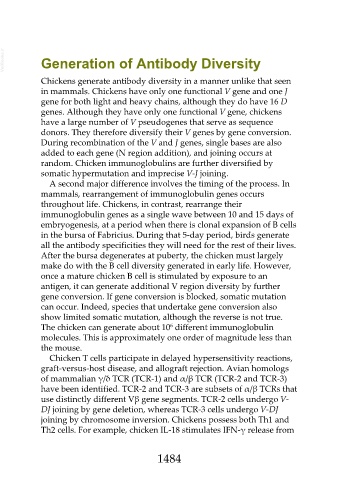Page 1484 - Veterinary Immunology, 10th Edition
P. 1484
VetBooks.ir Generation of Antibody Diversity
Chickens generate antibody diversity in a manner unlike that seen
in mammals. Chickens have only one functional V gene and one J
gene for both light and heavy chains, although they do have 16 D
genes. Although they have only one functional V gene, chickens
have a large number of V pseudogenes that serve as sequence
donors. They therefore diversify their V genes by gene conversion.
During recombination of the V and J genes, single bases are also
added to each gene (N region addition), and joining occurs at
random. Chicken immunoglobulins are further diversified by
somatic hypermutation and imprecise V-J joining.
A second major difference involves the timing of the process. In
mammals, rearrangement of immunoglobulin genes occurs
throughout life. Chickens, in contrast, rearrange their
immunoglobulin genes as a single wave between 10 and 15 days of
embryogenesis, at a period when there is clonal expansion of B cells
in the bursa of Fabricius. During that 5-day period, birds generate
all the antibody specificities they will need for the rest of their lives.
After the bursa degenerates at puberty, the chicken must largely
make do with the B cell diversity generated in early life. However,
once a mature chicken B cell is stimulated by exposure to an
antigen, it can generate additional V region diversity by further
gene conversion. If gene conversion is blocked, somatic mutation
can occur. Indeed, species that undertake gene conversion also
show limited somatic mutation, although the reverse is not true.
6
The chicken can generate about 10 different immunoglobulin
molecules. This is approximately one order of magnitude less than
the mouse.
Chicken T cells participate in delayed hypersensitivity reactions,
graft-versus-host disease, and allograft rejection. Avian homologs
of mammalian γ/δ TCR (TCR-1) and α/β TCR (TCR-2 and TCR-3)
have been identified. TCR-2 and TCR-3 are subsets of α/β TCRs that
use distinctly different Vβ gene segments. TCR-2 cells undergo V-
DJ joining by gene deletion, whereas TCR-3 cells undergo V-DJ
joining by chromosome inversion. Chickens possess both Th1 and
Th2 cells. For example, chicken IL-18 stimulates IFN-γ release from
1484

